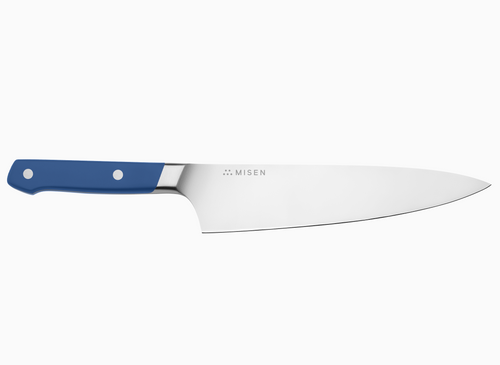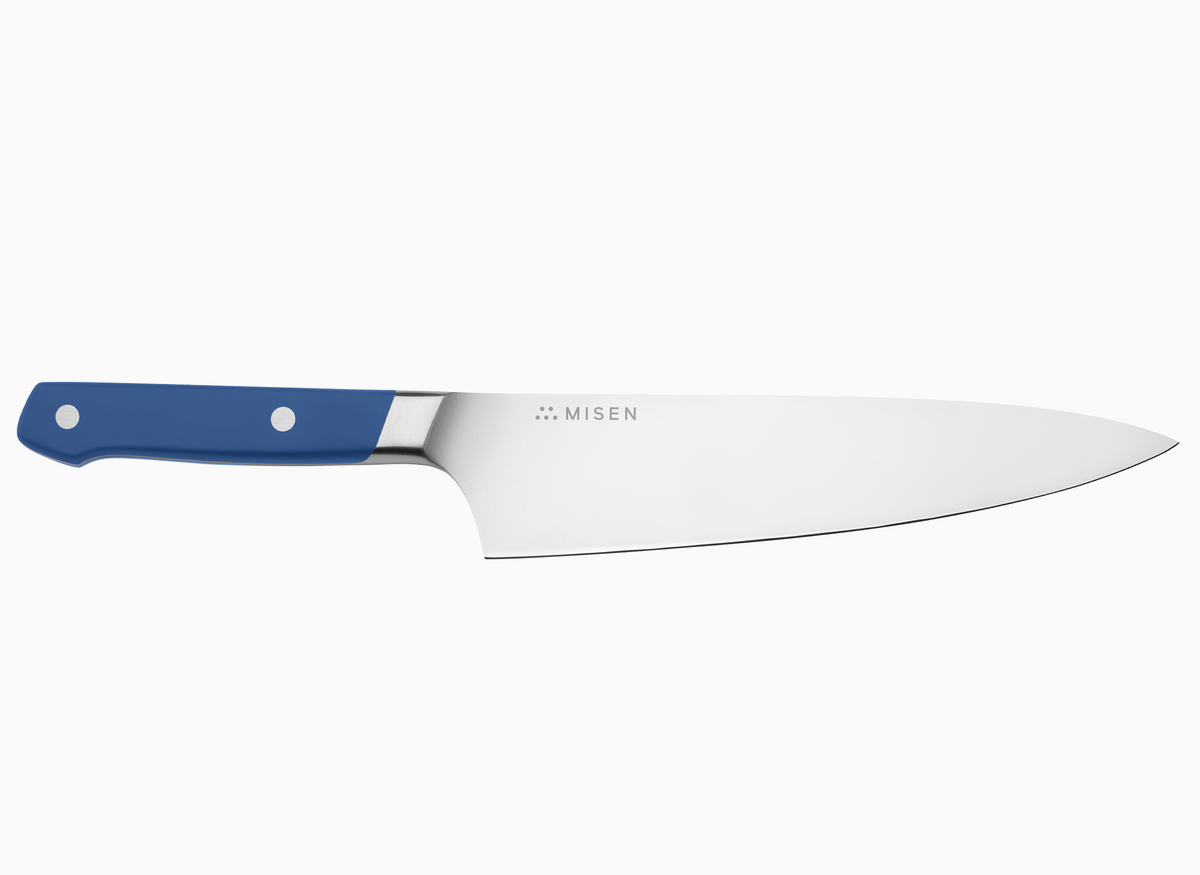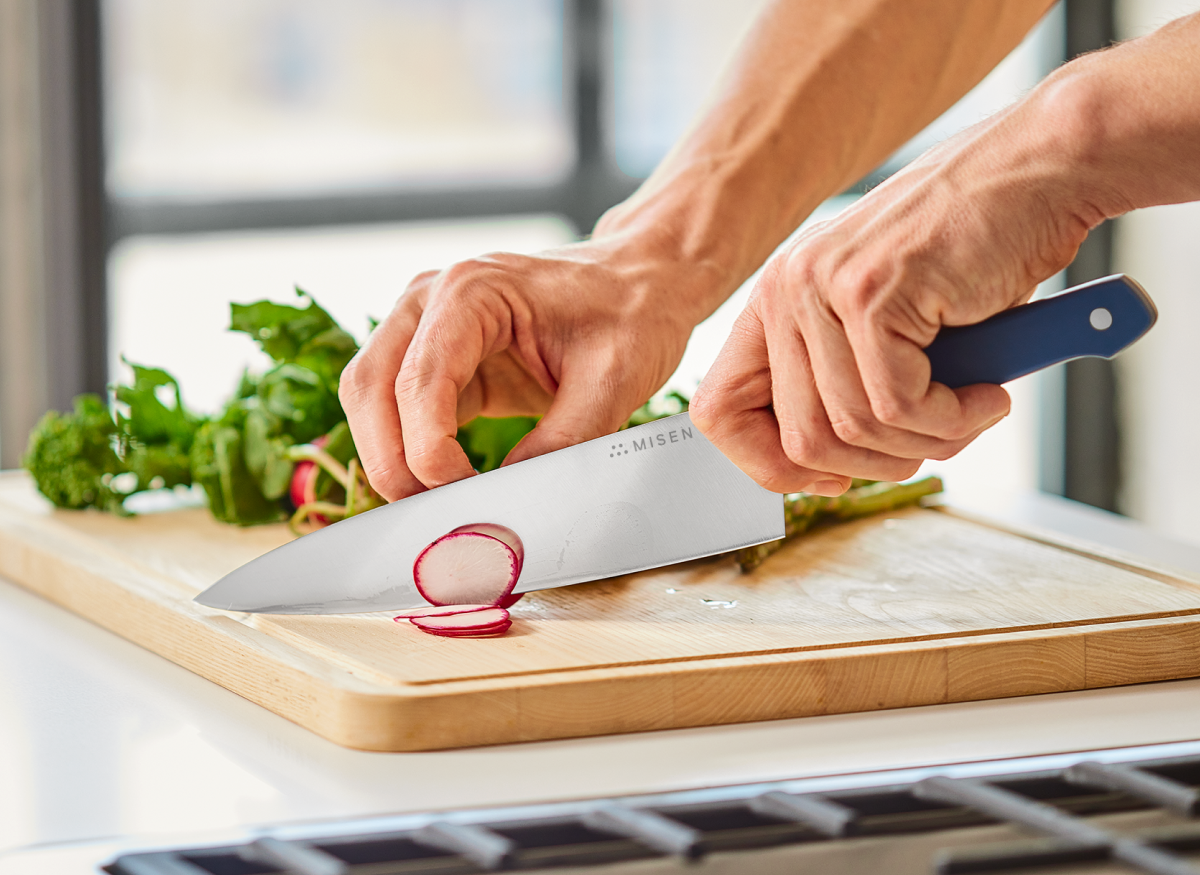Knife Blocks: What You Need to Know
 A knife block is one of the most recognizable items on any kitchen counter.
A knife block is one of the most recognizable items on any kitchen counter.
- Knife blocks can organize your knives while saving drawer space, but they’re not your only option.
- Knife blocks often come as sets with specific knives in them.
- A home chef only needs a few specific kitchen knives to get the job done.
You can see knife blocks everywhere: at the store, at your friend’s house, online, or in advertisements. They come in all sorts of varieties, and some have an absurd number of knives, including everything from kitchen shears to carving knives. Maybe you’ve considered buying one for yourself or as a gift for someone else. But what makes a cutlery block good for storage and what are the qualities of a good knife block set? What does a home cook really need, and how much should you spend? And why get a knife block set instead of individual knives? Let’s take a closer look at this kitchen staple.
Knife Block Basics
 A knife block will save you drawer space but take up counter space.
A knife block will save you drawer space but take up counter space.
Step back for a second and consider the basic purpose of a knife block. As knife storage devices, they have, essentially, three functions:
- They organize your knives.
- They save space in your kitchen.
- They keep the knives in a protected space to reduce the risk of injury.
That’s all. They will not turn an average home cook into Gordon Ramsay overnight — they simply help keep things in order and keep people from getting cut. A knife block helps a chef maintain their ‘mise en place’ a French term meaning ‘put in place.’ When things are where they should be, a chef’s life is much easier. But they’re not the only way to keep your kitchen organized.
In fact, knife blocks are one of our least favorite storage methods for several reasons:
- Knife blocks can collect germs if the knives are improperly cleaned or if the block is not regularly cleaned.
- Knife blocks dull knives over time with the repetitive scraping every time a knife is removed or put back into a knife block.
- Knife blocks take up valuable kitchen counter space.
- Knife blocks hide your knife blades, so unless you have your knife set memorized, you may have to check a few times to find the exact knife you want.
A magnetic knife holder or an in-drawer knife holder are usually better options. That said, a knife block is certainly better than leaving your knives loose in a drawer. And if you’re set on buying a knife block, we’re here to help.
Types of Knife Blocks
Knife blocks come in many shapes and sizes, and what a person chooses largely depends on their kitchen setup.
The most basic and most common version is the type you’ve likely seen the most: an upright wood block with slots for individual knives. Rather than having to use a drawer or otherwise valuable space, storing the knives upright in their designated position helps save drawer space but sacrifices counter space.
Another popular setup is the drawer knife block. These can be inserted into a drawer, saving counter space while still having designated spots for each specific knife. If you have more drawer space than counter space, this may be your best bet.
A third option, and our favorite, is a wall-mounted magnetic knife block. These setups save both counter and drawer space while having the added bonus of being neat. For safety, they’re best drilled into the wall and shouldn’t be attached with double-sided tape, since you certainly don’t want falling knives in your kitchen. A magnetic knife holder is sanitary, lets you know which knife is which, and saves space.
Many knife companies like Calphalon offer a self-sharpening kitchen knife set where the knife block contains slots with knife sharpeners inside. It’s a clever design, but the results of these sharpening slots are mixed. While a ‘sharpening’ block can help a knife maintain its edge, they don’t truly sharpen the knife and may wear away metal unnecessarily. In the long run, they’ll never replace true knife sharpening methods.
What Do You Need in a Knife Block Set?
 You can find good knife sets that don’t come in a knife block.
You can find good knife sets that don’t come in a knife block.
There are knives for just about every imaginable purpose. Some of them are so specific you’ll likely spend more time trying to figure out how to use them than actually using them — like knives made specifically for cutting grapefruit or lettuce. There are even cheese knives as if an ordinary knife couldn’t cut cheese.
Different types of metal are popular, too. Stainless steel knives are popular, as are high-carbon knives, and some knives are even ceramic. For durable knives with an extra-sharp edge, look for high-carbon stainless steel. Knives with a full-tang (a piece of metal that runs from the blade all the way to the end of the handle) will have better balance and give you an easier cutting experience.
But regardless of the type of knife, its job is the same: cutting. In reality, a home chef only needs a small cutlery set to get just about any job done. A 3-piece or 5-piece cutlery set is more than enough for most home chefs. We recommend having a chef’s knife, a paring knife, and a serrated knife for any home kitchen. These three knives should be able to tackle just about any job. A utility knife and a santoku knife can round out a set and add versatility to your kitchen.
The Chef’s Knife
A good chef’s knife is the most basic tool a person needs in their kitchen. If you were to only have one knife, this would be the one you want.
A chef’s knife usually ranges from 6-12 inches and features a long blade that curves upwards at the end. The curve is one of the main features: It allows the blade to rock back and forth on a cutting board for easy chopping, slicing, dicing, or mincing. You can cut just about anything with a chef’s knife. Additionally, the tapered point at the end of a chef’s knife allows for fine point work, like creating garnishes.
In western culinary tradition, there are two types of chef’s knives: French and German. The only difference is that the French version features a straighter blade until the end, while the German version features a longer curve to the blade. Neither blade is superior to the other — it’s entirely personal preference that dictates which one works better. Many home chefs would not notice the difference.
The Paring Knife
A paring knife is essentially a smaller version of a chef’s knife: a valuable all-rounder, indispensable in any kitchen. They come in many sizes but are on average a few to several inches long with a smaller handle and narrower blade than a chef’s knife.
A paring knife is perfect for peeling and cutting fruits and vegetables. Because of its small size, it doesn’t rock on a cutting board like a chef’s knife does, meaning it’s not capable of dicing or mincing without considerable extra effort. On the other hand, if your goal were, say, to peel and cut potatoes for boiling or roasting, a paring knife is your best bet.
The Serrated Knife
A serrated knife — often confused with or referred to as a bread knife — is perfect for cutting food with a tough outer layer and soft inner layer. This is because the knife acts like a saw, ripping through the outside while gliding easily through the inside.
A classic example, and the reason it’s often called a bread knife, is that the serrated knife is perfect for slicing a crusty loaf of bread. While a flat-bladed chef’s knife risks squishing the loaf flat due to the force needed to penetrate the crust, a serrated knife tears the crust without damaging or squishing the loaf.
Other ideal targets for a serrated knife, as opposed to a chef’s knife, are tomatoes, sausages, and citrus fruits. Again a chef’s knife — especially one that isn’t as sharp as it could be — risks squishing any of these or at best creating uneven slices.
The Utility Knife
A utility knife is exactly what it sounds like: an all-round knife useful for lots of different purposes. It’s larger than a paring knife and smaller than a chef’s knife with a thinner blade than a chef’s knife. Because it’s not specialized for any particular purpose, there are few things it can’t do. It can’t chop or dice as well as a chef’s knife and isn’t quite as wieldy for peeling vegetables or fruits as a paring knife. That said, if you need something cut and your other knives are being used or you just need something done quickly, a utility knife can be one of your best friends in the kitchen.
The Santoku Knife
A santoku knife is the Japanese version of a western chef’s knife. It has a flat blade rather than a curved blade and tapers off at the top towards the end of the blade, leaving a narrow point. It’s made for chopping, dicing, and mincing.
Because of its flat blade, it doesn’t rock on a cutting board, meaning chefs need to use a different technique when cutting. Chefs lift the blade and push forward with a santoku rather than relying on the board for balance.
Steak Knives
Rather than for cooking, steak knives are for cutting prepared food. But you probably already knew that. A steak knife set is useful for cutting any variety of meat, as well as doing anything else you’d do with a personal table knife: spreading butter, cutting vegetables, or slicing open a roll.
Should I Buy a Knife Block Set or Buy Individual Knives?
You can certainly buy a knife block and knives separately, but doing so leads to some risks. A universal knife block may not be able to fit the knives you purchase since neither all knife blocks nor all knives are made the same. It would be frustrating, for example, to discover that your knives didn’t conveniently fit in the block you had lovingly purchased for them.
Some of the more popular knife blocks are made by Zwilling J.A. Henckels International, Cuisinart, Kitchenaid, Chicago Cutlery, and Wusthof. For both sanitation and the longevity of the block, you wouldn’t want it made of soft wood like bamboo or pine. Instead, choose a hard wood like oak or acacia.
Misen’s knife set doesn’t come with a bulky and potentially icky knife block because we don’t think it’s necessary. Check out the magnetic knife bar option to keep your kitchen looking clean and modern without the worries that come with a universal knife block.
Who Needs a Knife Block Set?
 A good knife set should only include knives you’ll use.
A good knife set should only include knives you’ll use.
Essentially, anyone who loves to cook or is interested in learning how to cook better would do well to have some good knives in their kitchen. A knife set is a perfect gift for a person who has no knives, shoddy knives, or old knives. When your knives are high-quality and all the same type, you know you can rely on one just as much as the other.
One thing you don’t need to do, however, is spend a fortune on an 18-piece knife block set. Many knife block sets come with an outrageous number of knives, simply so the company can make more money off of you.
Additionally, a bulky knife block set can be a white elephant for someone with a small kitchen. It can take up valuable space and be largely useless due to the proliferation of useless knives. All a home cook truly needs are a few high-quality, useful knives rather than an overabundance of knives that will never see the light of day.
Using a high-quality, sharp knife makes cooking a pleasure rather than a chore. When you’re able and willing to cook more, you not only develop a lifelong skill, you’re also in greater control of your diet.
Find Your Knife Set With or Without a Knife Block
 When you love your knives, you’ll want to cook more often.
When you love your knives, you’ll want to cook more often.
When it comes to kitchenware, the sky is the limit in terms of cost. However, you certainly don’t need to spend an arm and a leg on an 18-piece knife set to get some high-quality knives.
Misen hits the sweet spot between cost and value, offering high-quality, high-carbon steel knives at a price that’s very manageable. Do yourself, a friend, or a loved one a favor and check out our knife sets to make cooking more fun.








